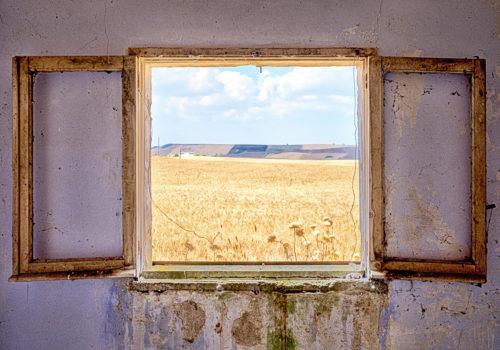Steven Seidenberg presents his book The Architecture of Silence: Abandoned Lives of the Italian South, published by Contrasto Books, examining the failed post-war land reform movement (called the Riforma Fondiaria in Italian) to which these imaged structures and landscapes belong.
Between 1952 and 1972, the Italian government implemented a land reform policy in a few key agrarian centers of the countryside, known as the Riforma Fondiaria. Funded by the Marshall Plan, the program placed land in the possession of impoverished families, but did so without the infrastructure
necessary to make the small holdings sustainable. This failure brought about a mass migration into the developing industrial North, leaving dozens upon dozens of post-war, often cast-concrete structures abandoned in the now machine cultivated fields.
In 2017, photographer Steven Seidenberg began exploring the landscapes, material culture, and remaining structures of this failed program in the vast agricultural areas of Basilicata and Puglia. The resultant series of images, collected for the first time in this volume, is not simply documentary, but presents the imperiled remnants of these absent lives in the form of hauntingly beautiful, painterly compositions. Again and again, these photographs reveal a poetic fragility that compels a primordial empathy in the viewer, drawing our attention to the lives destroyed through the Riforma, and thereby evoking the elemental complexity of loss and its aftermath the world over.
The accompanying volume—Distant Voices: On Steven Seidenberg’s Architecture of Silence—brings together essays by art historians, critics, curators, architects, philosophers, anthropologists, and archaeologists contextualizing the images and exploring the power and reach of the photographs.
In this collection of essays on photographer Steven Seidenberg’s The Architecture of Silence: Abandoned Lives of the Italian South, art historians, critics, curators, architects, philosophers, anthropologists, and archaeologists come together to discuss the power and reach of Seidenberg’s work. Reflecting on varied aspects of the collection and its subject, some of the authors focus on the formal qualities of the images in reference to landscape painting, others discuss them in the broader context of cultural heritage, while still others ruminate on the compositional complexity of Seidenberg’s practice as it both echoes and stands apart from a trajectory that includes Carlton Watkins, Bernd and Hilla Becher, Marsha Ginsburg, and Subhankar Banerjee, among others. Finally, the essays underscore the impact of an imaging project that privileges the formal elements of composition as a means to evoke the tragedy and joy of those whose lives have come and gone, by bearing witness to their traces––in turn a visual meditation on the poignant materiality of the human condition.
You can learn more about Steven Seidenberg by visiting his website and can order copies of The Architecture of Silence and Distant Voices: On Steven Seidenberg’s Architecture of Silence here. You can also follow him on Instagram: @steven.seidenberg
















